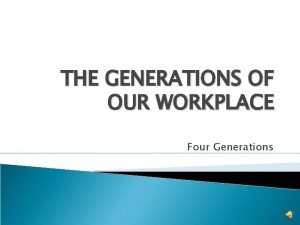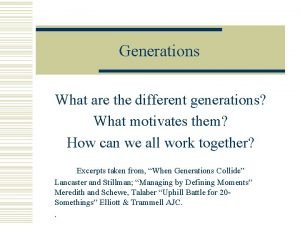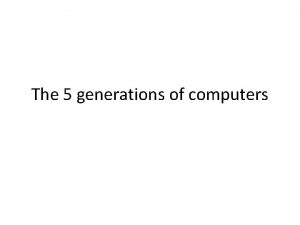Resource reallocations across generations the state the market











- Slides: 11

Resource reallocations across generations: the state, the market and the household Robert I. Gal (gal@demografia. hu) Conference on „Demographic Change in Central and Eastern Europe” Vienna, March 24, 2015

Structure of presentation 1. The social protection system (the welfare state) is an institution financing the lifecycle deficit through inter-age reallocation of resources 2. There alternative institutions as well, such as corporations and households, financing the lifecycle through inter-age reallocations. 2

The age profile of public spending 1. * These programmes represent ~60% of public spending. * No means tests are applied. → They help financing the lifecycle deficit through inter-age reallocations. (The poverty risk they mitigate is demographic. ) Source: Author’s calculation. Notes: Hungary, 2000; Per capita values by age-group in Forint. 3

The age profile of public spending 2. * Taxes are mostly paid by the active aged. * Beneficiaries are mostly the inactive aged. Source: Author’s calculation. Notes: Hungary, 2000; Per capita values by age-group in Forint. 4

Net public transfers • People in the inactive period of their life are net beneficiaries, people in their active period of their life are net contributors to the public transfer system • The elderly receive significantly more per capita than the children. Source: Author’s calculation. Notes: Hungary, 2000; Per capita values by age-group in Forint. 5

However: public transfers are far from enough to finance the lifecycle deficit • Lifecycle deficit (LCD) is the difference between consumption and labor income. • It is financed through public or private transfers or asset-based revenues. • Much of these reallocations, especially in childhood, are invisible in the current version of National Accounts. 6

A recent development in National Accounting: The National Transfer Accounts (NTA) • NTA (Lee and Mason 2011) describes national income as flows among people in different age. • NTA extends national accounting with the individual level. It captures intra-household and inter-household transfers, invisible in standard National Accounts, within and between households. • Elderly/child proportions change significantly. There is an asymmetry in the way childhood and old age are financed. 7

However: Economic activity and the resulting consumption are not fully captured by NTA • NTA does not go beyond the frontiers of National Accounts. It does not include unpaid household labor. • The lifecycle deficit that includes the production and consumption of unpaid household labor leaves a new area unaccounted for by public and private transfers. • Again, these reallocations, invisible in the current version of NTA, are particularly important in childhood. 8

A recent development in NTA: The National Time Transfer Accounts (NTTA) • NTA is extended with the National Time Transfer Account (NTTA; Donehower, 2012), which quantifies time transfers (value of household labor flowing from a cohort to another within the family). • Elderly/child proportions change once again. The asymmetry is further a 9

The full picture: The complete transfer package • Government is not the only provider of lifecycle finances. Neglecting alternative providers can lead to design errors. • If all forms of net transfers are taken into account society spends more resources on children than on the elderly. • However, the old cost society, whereas children cost parents. • Old age is financed through a single channel, visible to government, childhood is funded mostly by parents through unobserved channels.

Thank you! This project has received funding from the European Union’s Seventh Framework Programme for research, technological development and demonstration under grant agreement no 613247. 11
 Leader challenger follower nicher
Leader challenger follower nicher Market segmentation target market selection and positioning
Market segmentation target market selection and positioning Resource allocation vs resource leveling
Resource allocation vs resource leveling Perbedaan resource loading dan resource leveling
Perbedaan resource loading dan resource leveling Unit 5 the resource market
Unit 5 the resource market Chapter 5 competitive rivalry and competitive dynamics
Chapter 5 competitive rivalry and competitive dynamics Resource/factor market
Resource/factor market Market commonality and resource similarity
Market commonality and resource similarity Market commonality and resource similarity
Market commonality and resource similarity Generations
Generations Types of switching
Types of switching Organic basics proff
Organic basics proff





















